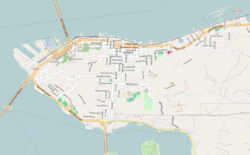| Fort Astoria | |
|---|---|
 The trading post as it was in 1813. | |
| Type | Fur trade post |
| Location | Astoria, Oregon |
| Constructed | 1811 |
| Built for | Pacific Fur Company |
| Abandoned | Unknown |
| Owner |
|
Fort Astoria | |
| Location | Astoria, Oregon |
| Coordinates | 46°11′18″N 123°49′39″W / 46.18820278°N 123.8274694°W |
| Built | 1811 |
| Part of | Astoria Downtown Historic District (ID98000631) |
| NRHP reference No. | 66000639 |
| Significant dates | |
| Added to NRHP | October 15, 1966[1] |
| Designated NHL | November 5, 1961[2] |
Fort Astoria (also named Fort George) was the primary fur trading post of John Jacob Astor's Pacific Fur Company (PFC). A maritime contingent of PFC staff was sent on board the Tonquin, while another party traveled overland from St. Louis. This land based group later became known as the Astor Expedition. Built at the entrance of the Columbia River in 1811, Fort Astoria was the first American-owned settlement on the Pacific coast of North America.
The inhabitants of the fort differed greatly in background and position, and were structured into a corporate hierarchy. The fur trading partners of the company were at the top, with clerks, craftsmen, hunters, and laborers in descending order. Nationalities included Americans, Scots, French Canadian voyageurs, Native Hawaiian Kanakas, and various indigenous North Americans, including Iroquois and others from Eastern Canada. They found life quite monotonous, with the fish and vegetable diet boring. Venereal diseases were problematic.[3] Types of fur taken in trade at the fort included beaver, sea otter, squirrel, and red fox.
The onset of the War of 1812 caused the PFC to fold as it was too isolated to expect any military protection or support from the United States. The Montreal-based North West Company (NWC) bought out the assets of the PFC in 1813, including Fort Astoria. They renamed it Fort George and utilized it as the headquarters of its most western operations, primarily based along the Columbia. In 1821, the Hudson's Bay Company incorporated Fort George into its collection of posts after absorbing the NWC. The opening of Fort Vancouver in 1825 was planned to allow for a better placed headquarters for the Columbia Department. While Fort George was abandoned in 1825, the arrival of American naval merchants on the Columbia necessitated the reopening of Fort George by the HBC.
Competition for control of Fort Astoria was a factor in the British and the Americans' resolving their disputed claims to the Oregon Country.[citation needed]
The Fort Astoria Site was added to the list of National Historic Landmarks on November 5, 1961. It is marked by a reconstructed block house.[2]
- ^ "National Register Information System". National Register of Historic Places. National Park Service. April 15, 2008.
- ^ a b "Fort Astoria Site". National Historic Landmark summary listing. National Park Service. Archived from the original on 2007-02-28. Retrieved 2008-07-05.
- ^ Nisbet 1994, pp. 209–214.
